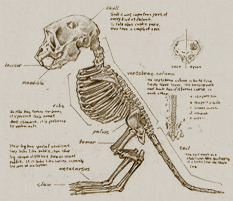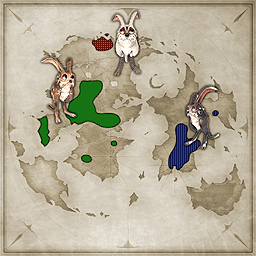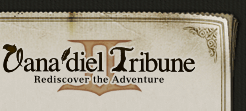Greetings, Vana'diel Tribune II readers. I am Atelloune, assistant to the famed biologist Professor Clavauert B Chanoix. Call me the "Wildlife Lady."
In this column, we'll be talking about the various wildlife that inhabits Vana'diel. It's a fast-paced, action-packed column, so try to keep up, okay?
Let's start with this question I received from a ninja who wishes to remain anonymous (big surprise):
Dear Wildlife Lady,
I was making my way through the Uleguerand Range the other day when I happened across a particularly mean-looking white rabbit. A girl in my party made a remark about how "cute" it was, but I begged to differ. This thing was glaring at me with its fiery red eyes, and I could swear that it was grinning... So I'd like to ask, what exactly was that thing?
Ah, perfect! It looks like we'll be discussing rabbits today-those cute, darling little creatures!
From here, I'll be showing you useful little snippets from page 315 of the professor's book, Professor Clavauert's Wildlife Encyclopedia:
Rabbits are herbivorous creatures that propel themselves by hopping with their powerful hind legs and tails. They are known for their distinctively long ears and charming eyes.
Now, I'll be the first to say that whether one finds those eyes "charming" or not is purely a subjective matter. Why not go see for yourself, then make the call?

Notice anything in the skeletal diagram to the left? Kudos to those who said that contrary to the development of the hind legs and tail, the front legs appear to have degenerated to the point of being almost vestigial. I guess they eat face-first--pretty wild!
As rabbits often dwell in hostile environments, their nest holes are a vital sanctuary for them. Rabbits will furiously defend their homes by kicking with their powerful hind legs, even against much larger creatures.
"Reckless" is one way to describe their behavior; "vicious" would be another. In any case, you can understand why so many adventurers have been on the receiving end of a rabbit kick.
Is everyone with me so far? Remember, this is going to be on the final exam! Now, we'll move on to the different species of rabbits and their respective habitats.
Question: What species of rabbit can be found throughout the entire Quon continent (for you geography buffs out there, that's Ronfaure, Zulkheim, Gustaberg, Derfland, and Vollbow)? By looking at the distribution map to the right, even the dullest Opo-opo can see that the answer is the Quon hare! Notice their distinctive brown fur with the snowflake-like spots.

There was once a trend among the San d'Orian aristocracy to keep a domesticated version of the Quon hare as a pet. As the trend began to fade, many of these creatures were abandoned in the forests of Ronfaure. These stray rabbits reproduced in massive numbers, causing a population boom in the region. On a side note, "Ronfaure" is the ancient Elvaan word for "rabbit hole."
A long time ago, I had pet rabbits as well. I started with one male and one female, but as you can guess, they multiplied very quickly. Then one night when I was sleeping, my parents released them all into the forest... I cried my eyes out the next day. "Why couldn't we grill and eat them instead?" I asked.
...Excuse me, I went off on a tangent there. Let's move on.
So which species of rabbit can be found in Sarutabaruta, Kolshushu and Li'Telor, collectively known as Mindartia? Why, rarabs, of course! They're known for their black fur, and the thin white stripes on their backs.
"Rarab" in ancient Tarutaru means "the bringer." There are many Tarutaru folktales that speak of rarabs delivering letters and repaying past kindnesses, which indicates a significant bond between these creatures and Tarutaru culture.
Rarabs have been kept in Tarutaru households for quite some time now. As pets, you ask? Come now--this is Windurst, the culinary capital of Vana'diel that we're talking about! Now wipe those tears away--it's time for the final question. What are the rabbits that live in regions to the north of Quon, like the mountains of Valdeaunia? Ack, I can't keep it to myself anymore! It's the polar hare, with fur as white as snow, and eyes as red as those of the students at the Acolyte Hostel. This is what our ninja friend saw.
There is a Hume legend that says polar hares are originally from the moon.
Ohhh, how magical and romantic! But don't forget, people: these are the biggest and meanest of the three species--proceed with extreme caution!
Still with me? Okay, then, let's finish off with a certain hypothesis written on page 337. Let's ignore for a moment that this one passage is still earning my professor the ridicule of the academic community:
Though they are of different colors, it is highly probable that these three rabbit species share the same ancestor, and thus all originate from the same region. The fact that the bone structures of the three species are nearly identical lends credence to this theory. As these creatures are relatively low on the food chain, it can be surmised that as they migrated to different regions, their fur changed color to blend in with their surroundings (i.e. as camouflage) in order to more effectively hide from predators.
And just how did these creatures change the color of their fur? Well, I can't think of a precise explanation...but could it really be a coincidence that white rabbits are only found in snowy terrain?
In the not-so-distant future, rabbits that live in the desert will turn a tawny color, while rabbits that live in caves will turn pitch-black. But their development will not stop with just color; eventually, even the bone structure of these creatures will begin to change according to their habitat, so that it better suits their environment.
Wow, quite a radical statement there, professor! But really, how long would it take to find out whether this theory is correct? A hundred years? A thousand? Ten thousand, maybe? Perhaps this isn't the most scientific thing to say, but only the Goddess knows...
So why don't we stuff this session in a nutshell with the following statement:
Quon hares, rarabs, and polar hares were originally one species, and indigenous to the same region (maybe).
Satisfied?





